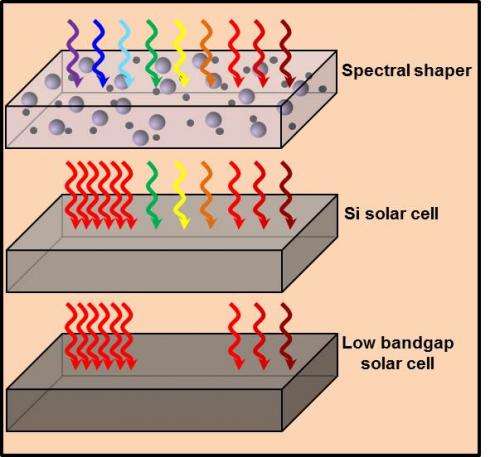Towards more efficient solar cells

A layer of silicon nanocrystals and erbium ions may help solar cells to extract more energy from the ultraviolet (UV, high-energy) part of the solar spectrum. Experimental physicists from the FOM Foundation, the STW Technology Foundation and the University of Amsterdam published this news in Nature Communications on 13th August 2014. When conventional silicon-based solar cells absorb UV light, much of its energy is lost in the form of heat. The researchers showed that this excess energy can be used to excite multiple erbium ions. This causes the ions to emit light, which can then be converted into electricity.
Conventional solar cells can only convert a small part of the solar spectrum into electricity efficiently. Low-energy light particles (photons) are not absorbed, as they do not have enough energy to bridge the band gap of the material from which solar cells are made. By contrast, high-energy photons can be absorbed, but in just a few picoseconds (10-12 seconds) much of their energy is transformed into heat. This limits maximum efficiency to just 30 percent.
Fast and efficient
Saba Saeed and her colleagues have now shown that the conversion efficiency can potentially be increased by making better use of the energy contained in these high-energy photons. This can be achieved with a layer consisting of silicon dioxide, silicon nanocrystals (particles with a size of a billionth of a meter) and erbium ions. The silicon nanocrystals transfer its excess energy to the erbium ions, before it is lost as heat. This leads to the emission of several low-energy infrared photons per absorbed photon, which can produce extra electricity. Compared to sunlight concentrators, which sometimes also make use of rare-earth metals such as erbium, this technique holds the prospect of a higher efficiency.
Spectral shaper
While the process has been demonstrated experimentally, it has not yet been used in a photovoltaic architecture (a solar cell). In the future, a layer of silicon nanocrystals and erbium ions could be placed on top of solar cells as a 'spectral shaper', to enhance their efficiency. The 'spectral shapers' would convert high-energy UV photons to several low-energy photons, which can then be used to generate electricity in a solar cell.
The follow-up study will focus on further refinement of the conversion layers by tweaking the size and spacing of the silicon nanocrystals, the concentration and type of rare-earth ion, and by optimizing the layer thickness. It will also be investigated if such a 'spectral shaper' can be integrated into the antireflective coating layer covering every solar cell.
More information: 'Efficient optical extraction of hot carrier energy', S. Saeed, E.M.L.D. de Jong, K. Dohnalova, and T. Gregorkiewicz. Nature Communications, 13 August 2014.
Journal information: Nature Communications
Provided by Fundamental Research on Matter (FOM)




















